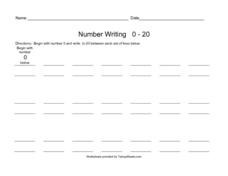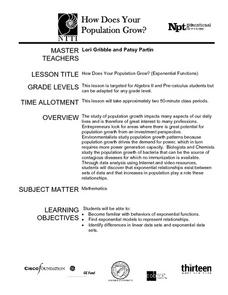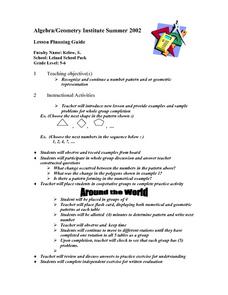Virginia Department of Education
Relationships Round Robin
Mathematics is all about patterns. Young mathematicians analyze geometric patterns to write algebraic expressions. They use the expressions to predict future stages of the patterns.
Curated OER
Small and Large Squares
Young mathematicians classify squares according to attributes. They sort squares according to specific attributes. Students explore squares in repeating patterns and order squares according to size. Engaging extension activities are...
Curated OER
Attributes of Polygons: Stretchy Shapes
Fourth graders use dancing methodology in a polygon and shape activity. In this shape and dance instructional activity, 4th graders discuss shapes in dance, math, and everyday life. Students use dancing activities to recognize and...
DK Publishing
Stars and Planets Connect the Dots
Reach for the stars with this cute connect-the-dots activity! Kindergartners practice their counting and number sequencing by connecting the numbers 1 through 6 or 10 in four different shapes. A rocketship is completed for them as an...
Curated OER
Number Line Up
A simple counting activity to help your kindergartners count in sequence. Hand out number cards randomly (one to represent each child in your class) to each class member. Now ask the class to put themselves in sequential order beginning...
Curated OER
Leaves for Our Tree
Young mathematicians review fact families and create a Math Fact Family Tree. This clever lesson plan includes some excellent printouts that support the lesson.
Georgia Learning Connections
Stand By Me!
Get your little mathematicians moving with this experiential activity in which one child is the "tens" and another is the "ones." They collect the number of unifix cubes (in tens or singles) assigned to their respective place values and...
Curated OER
Making Cranberry Bread
While the preparation for this lesson is extensive, the results are well worth the effort. Prior to the lesson, Xerox the pictures from Cranberry Thanksgiving by Wende and Harry Devlin, collect the ingredients for Cranberry Bread, and...
Desert Discoveries
How Old is Old? (And, How Much is a Million?)
Here is an interesting lesson on how old things are designed for young scientists. In it, learners compile a list of their birthdays, and the class puts them in sequential order from youngest to oldest. Then, they sequence 15 objects...
Curated OER
Investigation - Patterns/Functions
Students explore one-to-one correspondence. Through activities, students examine rhythm and patterns. From the patterns discovered, students create a visual representation of the pattern with blocks.
Curated OER
Telling Time Bingo
Have your youngsters examine the difference between digital and analog clocks. Using They participate in a "Telling Time BINGO" game. Not only is this activity fun, but it provides the teacher with an opportunity to informally assess his...
Curated OER
Comparing and Ordering Decimals - Complete Lesson Plan
Base ten blocks serve as visual representations of numbers that include decimals to the hundredths place. Children compare and order decimals in their math journal as they build the corresponding numbers with base ten blocks.
Curated OER
Ordering
Although there isn't much to this number ordering activity, it offers some solid practice in sequencing two and three-digit numbers. For each of the 20 sets of four numbers, learners re-write them in order from least to greatest. All...
Curated OER
Investigation - Distribution
Students match match one notice with one child for all children in their group. They will determine the correct number of notices needed by for the children in their group. Through activities, students discover one-to-one correspondence...
Curated OER
Number Writing 0 - 20
A straightforward tool for practicing writing numbers 1 through 20. Young scribes trace each number once, then write it independently. Ideas for games to make practice more fun and to extend understanding of the sequence of numbers...
Curated OER
Euclidean Direct Proofs
Learning how to prove theorems in geometry can be challenging. This resource explains what a proof is, and the different styles for proofs. It also contains links to web-based practice problems that help guide learners though example...
Curated OER
How Does Your Population Grown?
Do you know how the population has grown of your community? Can you predict the population over the next half century? Can we find an algebraic model that matches our data? These along with many more questions can be researched by...
Education World
High, Low, or In Between?
Trios play a card game that reinforces the concepts of number sequence and greater than and less than. Scholars make predictions based on information they know and a single unknown. They see cards drawn by others in the group, but not...
Curated OER
Everyday Mathematics: Multiples of 10
In this multiples of 10 worksheet, students sharpen their math skills as they learn to use multiples of 10 to help them with division and then try the 2 extra practice activities.
Curated OER
WebQuest: Thrills and Spills- Pick Your Park!
Students participate in a WebQuest in which they must determine which amusement park is the "median priced" park. Students visit park websites to accumulate prices for parking, activities, restaurants, and gift shops.
Illustrative Mathematics
Zeroes and factorization of a quadratic polynomial I
This activity uses the division algorithm and the definition of a zero/root of a function to guide your class to see the relationship between zeros and factors of a general quadratic, which can later be generalized to the Remainder...
Curated OER
Finding The Sum of an Infinite Series
Students examine finding the sum of an infinite series as the limit of partial sums. Through hands-on activities, students create their own sequence by finding the area of a square and then cutting it in half-sized pieces. They write...
Curated OER
Patterns and Geometric Representations
Students explore patterns and sequences. Given an example of each, they discuss their observations. In groups, students participate in an "Around the World" activity where they rotate to different stations in the classroom to determine...
SurfScore
Kodable
Prepare young scholars for life in the twenty-first century with this introduction to computer coding formatted as a fun problem solving game, this resource is a great way to develop children's sequential thinking skills.

























